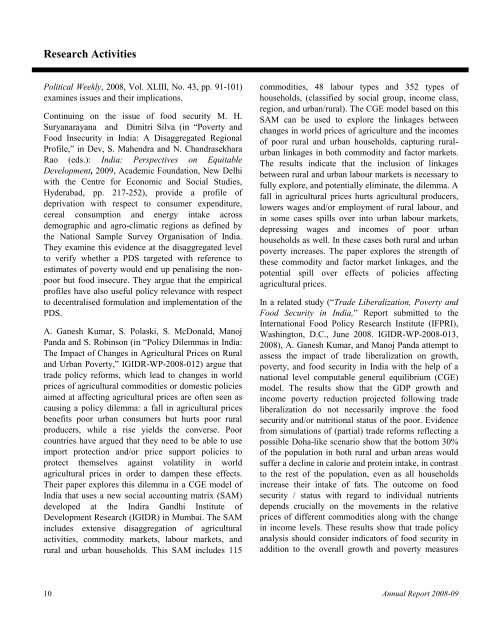IGIDR Annual Report 2008-2009 - Indira Gandhi Institute of ...
IGIDR Annual Report 2008-2009 - Indira Gandhi Institute of ...
IGIDR Annual Report 2008-2009 - Indira Gandhi Institute of ...
- No tags were found...
Create successful ePaper yourself
Turn your PDF publications into a flip-book with our unique Google optimized e-Paper software.
Research ActivitiesPolitical Weekly, <strong>2008</strong>, Vol. XLIII, No. 43, pp. 91-101)examines issues and their implications.Continuing on the issue <strong>of</strong> food security M. H.Suryanarayana and Dimitri Silva (in ―Poverty andFood Insecurity in India: A Disaggregated RegionalPr<strong>of</strong>ile,‖ in Dev, S. Mahendra and N. ChandrasekharaRao (eds.): India: Perspectives on EquitableDevelopment, <strong>2009</strong>, Academic Foundation, New Delhiwith the Centre for Economic and Social Studies,Hyderabad, pp. 217-252), provide a pr<strong>of</strong>ile <strong>of</strong>deprivation with respect to consumer expenditure,cereal consumption and energy intake acrossdemographic and agro-climatic regions as defined bythe National Sample Survey Organisation <strong>of</strong> India.They examine this evidence at the disaggregated levelto verify whether a PDS targeted with reference toestimates <strong>of</strong> poverty would end up penalising the nonpoorbut food insecure. They argue that the empiricalpr<strong>of</strong>iles have also useful policy relevance with respectto decentralised formulation and implementation <strong>of</strong> thePDS.A. Ganesh Kumar, S. Polaski, S. McDonald, ManojPanda and S. Robinson (in ―Policy Dilemmas in India:The Impact <strong>of</strong> Changes in Agricultural Prices on Ruraland Urban Poverty,‖ <strong>IGIDR</strong>-WP-<strong>2008</strong>-012) argue thattrade policy reforms, which lead to changes in worldprices <strong>of</strong> agricultural commodities or domestic policiesaimed at affecting agricultural prices are <strong>of</strong>ten seen ascausing a policy dilemma: a fall in agricultural pricesbenefits poor urban consumers but hurts poor ruralproducers, while a rise yields the converse. Poorcountries have argued that they need to be able to useimport protection and/or price support policies toprotect themselves against volatility in worldagricultural prices in order to dampen these effects.Their paper explores this dilemma in a CGE model <strong>of</strong>India that uses a new social accounting matrix (SAM)developed at the <strong>Indira</strong> <strong>Gandhi</strong> <strong>Institute</strong> <strong>of</strong>Development Research (<strong>IGIDR</strong>) in Mumbai. The SAMincludes extensive disaggregation <strong>of</strong> agriculturalactivities, commodity markets, labour markets, andrural and urban households. This SAM includes 115commodities, 48 labour types and 352 types <strong>of</strong>households, (classified by social group, income class,region, and urban/rural). The CGE model based on thisSAM can be used to explore the linkages betweenchanges in world prices <strong>of</strong> agriculture and the incomes<strong>of</strong> poor rural and urban households, capturing ruralurbanlinkages in both commodity and factor markets.The results indicate that the inclusion <strong>of</strong> linkagesbetween rural and urban labour markets is necessary t<strong>of</strong>ully explore, and potentially eliminate, the dilemma. Afall in agricultural prices hurts agricultural producers,lowers wages and/or employment <strong>of</strong> rural labour, andin some cases spills over into urban labour markets,depressing wages and incomes <strong>of</strong> poor urbanhouseholds as well. In these cases both rural and urbanpoverty increases. The paper explores the strength <strong>of</strong>these commodity and factor market linkages, and thepotential spill over effects <strong>of</strong> policies affectingagricultural prices.In a related study (―Trade Liberalization, Poverty andFood Security in India,‖ <strong>Report</strong> submitted to theInternational Food Policy Research <strong>Institute</strong> (IFPRI),Washington, D.C., June <strong>2008</strong>. <strong>IGIDR</strong>-WP-<strong>2008</strong>-013,<strong>2008</strong>), A. Ganesh Kumar, and Manoj Panda attempt toassess the impact <strong>of</strong> trade liberalization on growth,poverty, and food security in India with the help <strong>of</strong> anational level computable general equilibrium (CGE)model. The results show that the GDP growth andincome poverty reduction projected following tradeliberalization do not necessarily improve the foodsecurity and/or nutritional status <strong>of</strong> the poor. Evidencefrom simulations <strong>of</strong> (partial) trade reforms reflecting apossible Doha-like scenario show that the bottom 30%<strong>of</strong> the population in both rural and urban areas wouldsuffer a decline in calorie and protein intake, in contrastto the rest <strong>of</strong> the population, even as all householdsincrease their intake <strong>of</strong> fats. The outcome on foodsecurity / status with regard to individual nutrientsdepends crucially on the movements in the relativeprices <strong>of</strong> different commodities along with the changein income levels. These results show that trade policyanalysis should consider indicators <strong>of</strong> food security inaddition to the overall growth and poverty measures10 <strong>Annual</strong> <strong>Report</strong> <strong>2008</strong>-09
















